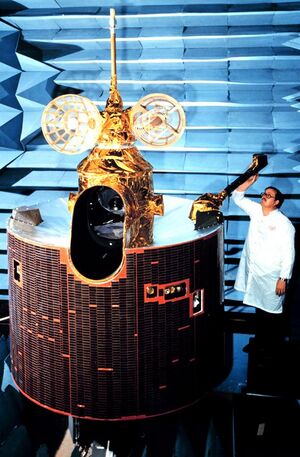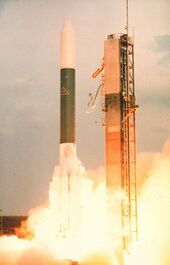Engineering:GOES 4
 GOES-D before launch | |
| Mission type | Weather satellite |
|---|---|
| Operator | NOAA/NASA |
| COSPAR ID | 1980-074A |
| Mission duration | 7 years (planned) 8.2 years (achieved) |
| Spacecraft properties | |
| Bus | HS-371 |
| Manufacturer | Hughes |
| Launch mass | 660 kilograms (1,460 lb) |
| Start of mission | |
| Launch date | 9 September 1980, 22:27 UTC |
| Rocket | Delta 3914 |
| Launch site | Cape Canaveral Air Force Station LC-17A |
| Contractor | McDonnell Douglas |
| End of mission | |
| Disposal | Decommissioned |
| Deactivated | 9 October 1988 |
| Orbital parameters | |
| Reference system | Geocentric |
| Regime | Geostationary |
| Longitude | 98° West (1980-1981) 135° West (1981-1983) 139° West (1983-1984) 10° West (1985) 44° West (1985-1988) |
| Slot | GOES-WEST (1981-1983) |
| Period | 24 hours |
GOES-4, known as GOES-D before becoming operational, was a geostationary weather satellite which was operated by the United States National Oceanic and Atmospheric Administration as part of the Geostationary Operational Environmental Satellite system.[1] Launched in 1980, it was used for weather forecasting in the United States, and later in Europe. Following its retirement it became the first satellite to be sent into a graveyard orbit.
Limited lifespan
GOES-4 was built by Hughes Space and Communications, and was based around the HS-371 satellite bus. At launch it had a mass of 660 kilograms (1,460 lb),[2] with an expected operational lifespan of around seven years.[3] It was the first HS-371 based GOES satellite.[4]
Launch and orbit
GOES-D was launched using a Delta 3914 carrier rocket flying from Launch Complex 17A at the Cape Canaveral Air Force Station .[5] The launch occurred at 22:27 GMT on 9 September 1980.[6] The launch successfully placed GOES-D into a geosynchronous transfer orbit, from which it raised itself to geostationary orbit by means of an onboard Star-27 apogee motor. Its insertion into geostationary orbit occurred at 12:00 on 11 September.[7]
Following its insertion into geostationary orbit, GOES-4 was positioned at 98° West. In 1981, it was moved to 135° West, where it remained until 1983 when it was moved to 139° West (1983–1984). In 1985 it was repositioned at 10° West, and later 44° West, where it provided coverage of Europe for EUMETSAT following the failure of the Meteosat-2 spacecraft.[8]
Graveyard orbit
Following the end of its operations over Europe, GOES-4 was retired from service. It became the first spacecraft to be raised out of geosynchronous orbit, into a graveyard orbit for disposal.[9] This was accomplished on 9 November 1988, using remaining propellent in the satellite's station-keeping thrusters.
See also
- 1980 in spaceflight
References
- ↑ "GOES-4". The GOES Program - ESE 40th Anniversary. NASA. http://goes.gsfc.nasa.gov/text/history/goes/goes4.html. Retrieved 2009-08-14.
- ↑ "GOES-4". NSSDC Master Catalog. US National Space Science Data Center. https://nssdc.gsfc.nasa.gov/nmc/spacecraft/display.action?id=1980-074A. Retrieved 2009-08-14.
- ↑ "Hughes Checks Out GOES-D". Flight International. 1980-08-16. p. 598.
- ↑ Krebs, Gunter. "GOES-4, 5, 6, G, 7". Gunter's Space Page. http://space.skyrocket.de/doc_sdat/goes-d.htm. Retrieved 2009-08-14.
- ↑ Wade, Mark. "GOES". Encyclopedia Astronautica. http://www.astronautix.com/craft/goes.htm. Retrieved 2009-08-14.
- ↑ McDowell, Jonathan. "Launch Log". Jonathan's Space Page. http://planet4589.org/space/log/launchlog.txt. Retrieved 2009-08-14.
- ↑ McDowell, Jonathan. "Index". Geostationary Orbit Catalog. Jonathan's Space Page. http://planet4589.org/space/log/geo.date. Retrieved 2009-08-14.
- ↑ "CONSOLIDATED REPORT OF CGMS ACTIVITIES". CGMS. 2003-10-15. p. 20. Archived from the original on 2007-12-12. https://web.archive.org/web/20071212053601/http://www.eumetsat.int/Home/Main/Publications/CGMS_Publications/General_CGMS_Documents/groups/cps/documents/document/pdf_cgms_01.pdf. Retrieved 2009-08-14.
- ↑ "Weather Eyes". Flight International. 1989-03-11. p. 27.
 |


